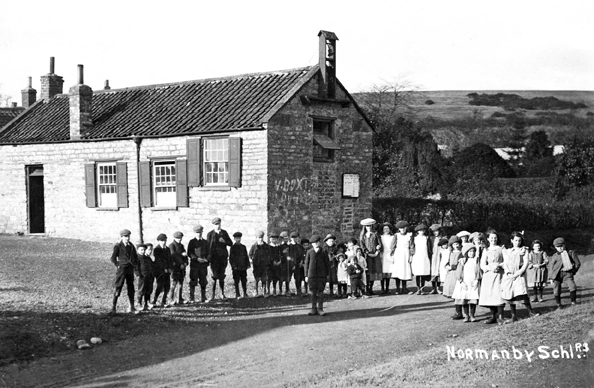1700 AD
Judith Boynton founded a free school by her will in November
1700. Her estate called White Carrs at
Thornton Riseborough was charged with the annual
sum of £6, £5 was for a schoolmaster and £1 for purchasing bibles for the
poor. The money came from rented farmland. The parish register
reveals a tough life in those days. In March 1714 James Brown and his
wife Mary buried their son. By July of the same year Mary was dead -
very probably due to childbirth complications.

Normanby School c.1910
In May 1715 James, a yeoman, married Elizabeth Carlin (a yeoman
was a free tenant but as he worked with his hands he was not a 'gentleman',
although above the status of other tenants). Their daughter, Penelope,
was baptised in March 1716 but was buried in October of the same year.
Yet by January 1717 another daughter, again called Penelope, was baptised, but
she was dead by June the following year. It was common to use family
names again if off-spring died.
Life was full of dramatic events on a background of day to day
routine toil in the fields. If a person could survive the then fatal
childhood illnesses and become used to the water then they could live to a
ripe old age. There are records of between 80 and 97 years.
Other names in the parish register that century included
Dawson, Hatter, Dring, Hinds,
Sparling, Borriman, Chambers,
Sigsworth, Marshall, Walton, Barker, Barton, Cook,
Tyndal, Savage, Jackson and Flinders. The
Rector for much of this time was Christopher Bowes, later Richard Hill.
Churchwardens included George Sparling.
Philip Bainbridge was the curate in 1715, Philip Dowkes
for the latter half of the century. The blacksmith in 1735 was Rob
Wilson.
The main occupations were naturally related to farming.
Some parish register entries mention jobs including John
Huddlestone, weaver; William Douthwaite and
James Thompson, day labourers; John Thompson, pauper; Joseph
Brough and John Browne,
manservant's; Thomas Bolton, Flax Draper; William
Harrison a Sergeant in the North Yorkshire Militia; Robert
Trowsdale of Normanby
House, a carpenter; John Taylor a Waggoner to Mr
Stockdale at Sinnington House.
This period included the passing of many acts of parliament to
enclose agricultural land. Before 1735 the death penalty for witchcraft
still applied. The improvement of some roads through the creation of
turnpike trusts enabled quicker stagecoach services. They provided
tempting targets for robbers and highwaymen.
In 1750 or thereabouts Pasture House was built and became the
home of the blacksmith. John Wesley visited the area in 1764.
In 1795 the Whig government introduced allowances for
unemployed or low paid workers. As a result many farmers began to reduce wages
and employ labourers on a casual basis. Sometimes whole parishes were
living on the dole according to Poor laws dating back to 1597 and 1601.
As a result an act in 1834 said that no able bodied person could obtain relief
except by entering a workhouse. This rule led to miserable lives for
many poor people.
Top